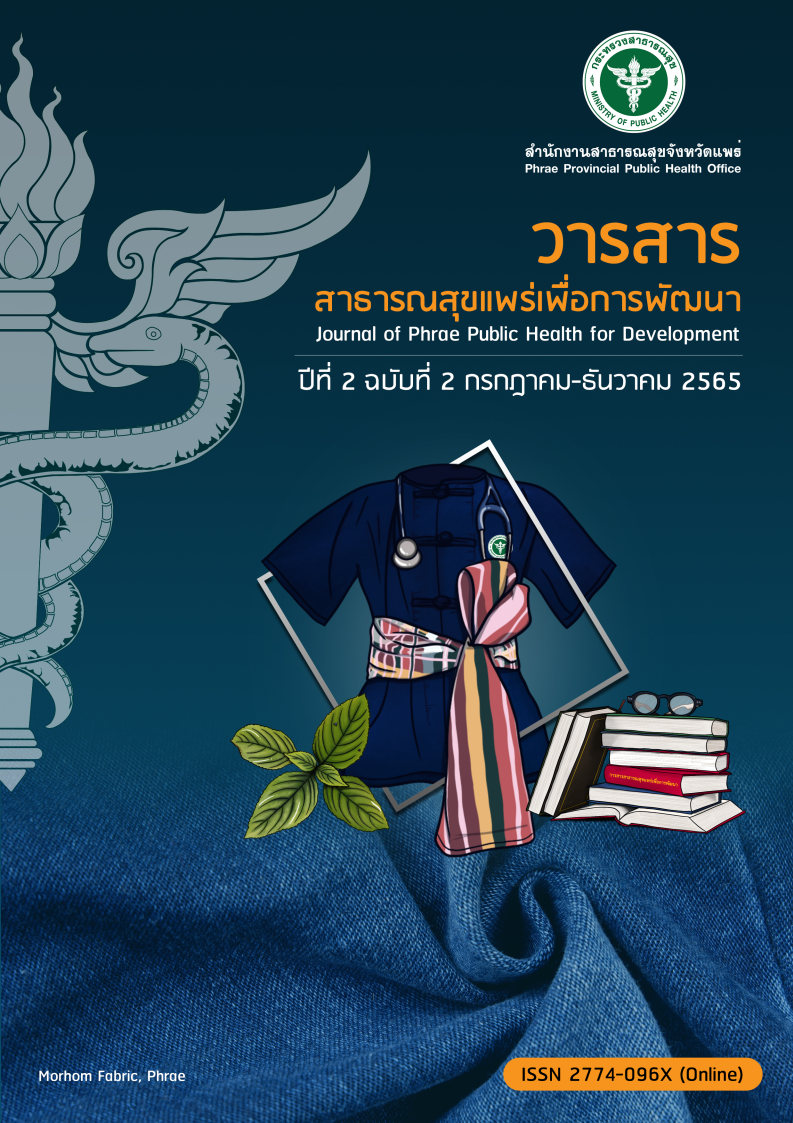การศึกษาอุบัติการณ์ที่อาจจะเกิดโรคธาลัสซีเมียชนิดรุนแรงในเด็กที่เกิดจากคู่เสี่ยงหญิงตั้งครรภ์ คลินิกฝากครรภ์ โรงพยาบาลลอง อำเภอลอง จังหวัดแพร่
คำสำคัญ:
ธาลัสซีเมีย, การตรวจคัดกรองธาลัสซีเมีย, โรคธาลัสซีเมียชนิดรุนแรงบทคัดย่อ
การวิจัยนี้มีวัตถุประสงค์ 1) เพื่อศึกษาความชุกของหญิงตั้งครรภ์และคู่เสี่ยงที่ให้ผลบวกต่อการตรวจคัดกรองหาพาหะธาลัสซีเมียเบื้องต้น 2) เพื่อศึกษาความชุกของคู่เสี่ยงที่มีโอกาสได้บุตรเป็นโรคธาลัสซีเมียชนิดรุนแรง 3) เพื่อศึกษาอุบัติการณ์ของธาลัสซีเมียชนิดรุนแรงจากการตรวจ
คัดกรอง และ 4) เพื่อนำข้อมูลไปใช้ประกอบการวางแผนเพื่อดำเนินงานป้องกันและควบคุม
ธาลัสซีเมียในโรงพยาบาลลอง กลุ่มตัวอย่างคือหญิงตั้งครรภ์ที่มาฝากครรภ์ที่โรงพยาบาลลอง จังหวัดแพร่ จำนวน 467 ราย ผลการศึกษาพบว่าหญิงตั้งครรภ์ที่ให้ผลบวกและลบต่อการคัดกรองธาลัสซีเมียเบื้องต้นคิดเป็นร้อยละ 40.47 และร้อยละ 59.53 ตามลำดับ โดยจำนวนหญิงตั้งครรภ์ให้ผลบวกต่อการตรวจคัดกรองธาลัสซีเมียแยกเป็นหญิงตั้งครรภ์ที่มีการทดสอบ DCIP test ให้ผลบวกคิดเป็นร้อยละ 12.83 ค่าดัชนีเม็ดเลือดแดง MCV<80 fL คิดเป็นร้อยละ 62.03 และการทดสอบ DCIP test ให้ผลบวกรวมกับค่า MCV<80 fL คิดเป็นร้อยละ 26.20 คู่เสี่ยงสามีของหญิงตั้งครรภ์ที่มีผลบวกต่อการคัดกรองธาลัสซีเมียพบว่ามีผลตรวจเข้าคู่กันผิดปกติทั้งคู่
ต้องส่งไปตรวจต่อไปคิดเป็นร้อยละ 28.04 ส่วนคู่เสี่ยงหญิงตั้งครรภ์และสามีที่มีผลตรวจเข้าคู่กันแล้วพบว่าสามีมีผลปกติ คิดเป็นร้อยละ 71.96 คู่เสี่ยงหญิงตั้งครรภ์และสามีที่มีผลตรวจผิดปกติทั้งคู่ต้องส่งไปตรวจต่อพบว่ามีจำนวนคู่เสี่ยงที่บุตรมีความเสี่ยงและไม่มีความเสี่ยงเป็นโรคธาลัสซีเมียชนิดรุนแรง คิดเป็นร้อยละ 24.53 และร้อยละ 75.47 ตามลำดับ โดยจากจำนวนคู่เสี่ยงที่บุตรมีความเสี่ยงเป็น
โรคธาลัสซีเมียชนิดรุนแรง สามารถจำแนกชนิดของโอกาสเกิดโรคธาลัสซีเมียชนิดรุนแรงในคู่เสี่ยงได้ดังนี้ Hb' Bart's hydrops fetalis คิดเป็นร้อยละ 23.08, Beta-thalasemia/Hb E Disease คิดเป็นร้อยละ 61.54 และ Beta thalassemia Disease
คิดเป็นร้อยละ 15.38
ดาวน์โหลด
เผยแพร่แล้ว
วิธีการอ้างอิง
ฉบับ
บท
การอนุญาต
ลิขสิทธิ์ (c) 2021 สำนักงานสาธารณสุขจังหวัดแพร่

This work is licensed under a Creative Commons Attribution-NonCommercial-NoDerivatives 4.0 International License.





